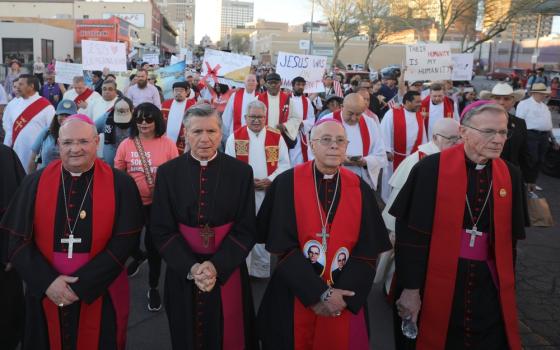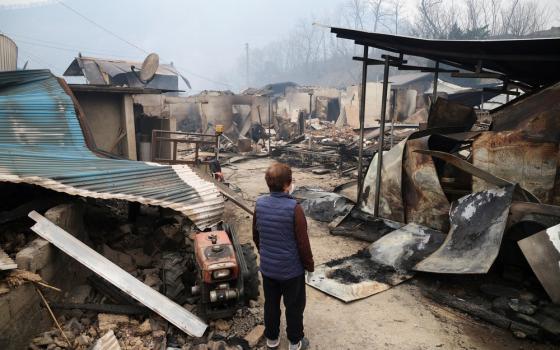
Religious Life
Though it’s usually said with great caution, hemmed in with enough qualifications and caveats to feel almost like death by a thousand cuts, nonetheless talk of a rebound in men’s religious life in America is quietly making the rounds.
While relations between some orders and church officialdom still have their ups and downs, overall there are signs of an improving climate. For example, the keynote speaker for the most recent assembly of the Conference of Major Superiors of Men, the main umbrella group for men’s orders in the United States, was the papal nuncio, Italian Archbishop Pietro Sambi, who voiced admiration and encouragement for the work of religious orders in America.
Now, a new study has revealed some rays of light on the vocations front.
Sponsored by the National Religious Vocations Conference and conducted by Georgetown University’s Center for Applied Research in the Apostolate in Washington, the 406-page study was released in early August. It contains a massive amount of data, but here’s one sample finding: Fully 43 percent of new members of religious orders today, both men and women, are under the age of 30.
Holy Cross Br. Paul Bednarczyk, executive director of the National Religious Vocations Conference, spoke with NCR in late August about the study, a multiyear effort based on surveys of religious institutes, focus groups with new members, and a close-up examination of selected orders that have been especially successful in attracting and retaining new members.
NCR: What do we learn from this study?
Bednarczyk: First of all, that religious life has a future. While the numbers aren’t huge, the presence of young people is striking. Where once many people were looking at older vocations, we found that among men the average age of new entrants is 30. Second, we’re becoming more diverse, and not just in terms of culture, ethnicity and language. Seventy percent of new entrants now have at least a bachelor’s degree, and many have either had full-time jobs or were doing some sort of church ministry before they entered.
What works in generating vocations?
The days are long gone when a vocations director can simply sit in his office waiting for candidates to come to his door. You have to be present where young people are, which means ministries that target young audiences, and it means the Internet. You have to be proactive.
Communities with a full-time vocations director, working as part of a team, have a higher percentage of new members. The team can be made up of laypeople, other members of the community, or whoever. What matters is that at some point in the history of the congregation, a commitment was made to building a vocations culture, so it’s not just the vocations director. There’s a sense of corporate responsibility. They’ve done the internal work to understand what this means. All members are vocations directors, in that they feel a responsibility to give witness and to actively invite people to join them. They give an example of joy, integrity, and the conviction that their charism is a gift to the church.
Can you point to an example of a community that does this especially well?
In the study, we looked at three men’s orders that have had success: the Divine Word Missionaries of the Chicago province; my own community, the Holy Cross Fathers of the Indiana province; and the Marianists. At Moreau Seminary [a Holy Cross seminary adjacent to Notre Dame], we’ve got 11 new candidates. There’s been an awful lot of work done in this area within the congregation itself.
What else works?
You’ve got to be present on the Internet, including making use of online promotional materials, keeping your Web site up to date, and so on. Given the diminishing numbers in religious life, young people are more likely to meet a congregation when they Google “vocations” than physically. Having a successful Web presence helps, including social networking, Facebook and Twitter. Some communities post video clips, or invite people to e-mail members of the community. At [the National Religious Vocations Conference], we launched a vocation-network.org site in response to sites like eHarmony.com, in this case connecting candidates with communities. You can fill out an online profile, which includes things like your geographic region, desired community size, whether or not they wear a habit, etc., and at the end a list of maybe 20 communities pops up where you can begin your discernment. We used to rely on mail-in coupons, which would generate maybe 1,000 responses a year. Over three years, this Web effort is averaging about 7,000 responses a year, which obviously confirms the importance of being on the Internet. A high percentage of these Web contacts say they expect to be in an initial formation somewhere within a year.
 You don’t want to be too slick, of course. What’s most important is that there has to be consistency between what you say about yourself on the Web site and how your community actually lives. If a candidate comes in and senses an inconsistency with the lived reality, they’ll move on.
You don’t want to be too slick, of course. What’s most important is that there has to be consistency between what you say about yourself on the Web site and how your community actually lives. If a candidate comes in and senses an inconsistency with the lived reality, they’ll move on.
The thing to remember is that these are only tools to bring someone into contact with a real person. Relationships are ultimately what make the difference. Any program or event that brings a potential candidate into relationship with members of a community is very helpful, such as “Come and See” weekends, retreats and so on.
What about traditional springboards for vocations, such as Catholic schools?
The study found a difference between men and women in terms of how they find the community they end up joining. Men are more likely to learn about their community by going to a school or other institution sponsored by that community. Women, on the other hand, either know members of the community personally or were recommended by a friend. Partly, I think that’s because men’s orders are still connected to the institutions they sponsor a bit more thoroughly, so that the religious are still a presence within those institutions.
The conclusion seems obvious: If we want vocations, we need to put our members into ministries where they’re most likely to come into contact with target groups, which means being present in schools, doing campus ministry, youth ministry and so on.
What style of religious life seems most attractive to younger members today?
Communities with a strong sense of Catholic identity are clearly finding more vocations. As one sign of that, two-thirds of younger members belong to communities that wear the habit. That’s only one manifestation of identity, however. Younger members are also concerned with prayer styles, commitment and fidelity to church teachings, and a strong community life. They’re interested in a disciplined prayer life, including the daily Eucharist, the liturgy of the hours, and traditional Catholic devotional practices.
Why is that?
I think generations have a lot to do with it. Religious today under 30 have had a very different experience of church than their older brothers and sisters, who came in during the Second Vatican Council (1962-65) or before. For the younger ones, their defining experience has been John Paul II and now Benedict XVI, emphasizing a strong sense of Catholic identity and a call to service. That’s what they’re responding to. They’re not making judgments about other communities, but they’re simply going to those communities that respond to their needs.
Does the study find significant differences between men and women?
The broad trends apply equally to men and women, but there are some interesting wrinkles. For example, more men are in formation right now than women, even though there are fewer men’s institutions. The men, however, have a lower retention rate. In part, I suspect that’s because some men’s communities have pre-seminary and pre-novitiate programs where there’s greater turnover. Three-quarters of men are in seminary formation leading to the priesthood, while one-quarter are preparing for religious brotherhood.
 Men are also more likely to have participated in youth ministry programs before entering religious life, which again illustrates the imporance of that kind of outreach.
Men are also more likely to have participated in youth ministry programs before entering religious life, which again illustrates the imporance of that kind of outreach.
One interesting point about the habit is that 48 percent of men who belong to a community without a habit said they’d wear one if they had that option, but only 25 percent of women said that. Sometimes the perception is that it’s the women who are embracing the habit most enthusiastically, but that’s not what the study showed.
What’s the bottom line?
Our numbers are smaller, but religious life is going to continue. I hope that the study will serve as a benchmark for this century, because sometimes I think we keep comparing today’s membership numbers with the post-World War II surge, which actually was an anomaly. But that’s what we know, so it’s what we think about. I think this study gives us a better baseline for looking ahead.
Over our 2,000-year history, religious life has undoubtedly faced greater challenges than those confronting us today. Whatever happens, the religious will still be here.
John L. Allen Jr. is NCR senior correspondent. His e-mail address is jallen@ncronline.org.




